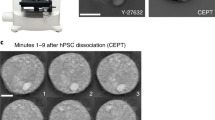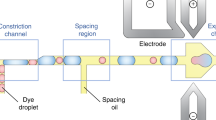Abstract
Cell fusion has been used for many different purposes, including generation of hybridomas and reprogramming of somatic cells. The fusion step is the key event in initiation of these procedures. Standard fusion techniques, however, provide poor and random cell contact, leading to low yields. We present here a microfluidic device to trap and properly pair thousands of cells. Using this device, we paired different cell types, including fibroblasts, mouse embryonic stem cells and myeloma cells, achieving pairing efficiencies up to 70%. The device is compatible with both chemical and electrical fusion protocols. We observed that electrical fusion was more efficient than chemical fusion, with membrane reorganization efficiencies of up to 89%. We achieved greater than 50% properly paired and fused cells over the entire device, fivefold greater than with a commercial electrofusion chamber and observed reprogramming in hybrids between mouse embryonic stem cells and mouse embryonic fibroblasts.
This is a preview of subscription content, access via your institution
Access options
Subscribe to this journal
Receive 12 print issues and online access
$259.00 per year
only $21.58 per issue
Buy this article
- Purchase on Springer Link
- Instant access to full article PDF
Prices may be subject to local taxes which are calculated during checkout





Similar content being viewed by others
References
Blau, H.M. et al. Plasticity of the differentiated state. Science 230, 758–766 (1985).
Kohler, G. & Milstein, C. Continuous cultures of fused cells secreting antibody of predefined specificity. Nature 256, 495–497 (1975).
Miller, R.A. & Ruddle, F.H. Pluripotent teratocarcinoma-thymus somatic-cell hybrids. Cell 9, 45–55 (1976).
Tada, M., Tada, T., Lefebvre, L., Barton, S.C. & Surani, M.A. Embryonic germ cells induce epigenetic reprogramming of somatic nucleus in hybrid cells. EMBO J. 16, 6510–6520 (1997).
Wilmut, I., Schnieke, A.E., McWhir, J., Kind, A.J. & Campbell, K.H.S. Viable offspring derived from fetal and adult mammalian cells. Nature 385, 810–813 (1997).
Matveeva, N.M. et al. In vitro and in vivo study of pluripotency in intraspecific hybrid cells obtained by fusion of murine embryonic stem cells with splenocytes. Mol. Reprod. Dev. 50, 128–138 (1998).
Tada, M., Takahama, Y., Abe, K., Nakatsuji, N. & Tada, T. Nuclear reprogramming of somatic cells by in vitro hybridization with ES cells. Curr. Biol. 11, 1553–1558 (2001).
Flasza, M. et al. Reprogramming in inter-species embryonal carcinoma-somatic cell hybrids induces expression of pluripotency and differentiation markers. Cloning Stem Cells 5, 339–354 (2003).
Jahn, R., Lang, T. & Sudhof, T.C. Membrane fusion. Cell 112, 519–533 (2003).
Pontecorvo, G. Production of mammalian somatic-cell hybrids by means of polyethylene-glycol treatment. Somatic Cell Genet. 1, 397–400 (1975).
Davidson, R.L. & Gerald, P.S. Improved techniques for induction of mammalian-cell hybridization by polyethylene glycol. Somatic Cell Genet. 2, 165–176 (1976).
Vienken, J. & Zimmermann, U. Electric field induced fusion—electrohydraulic procedure for production of heterokaryon cells in high yield. FEBS Lett. 137, 11–13 (1982).
Zimmermann, U. & Vienken, J. Electric field-induced cell-to-cell fusion. J. Membr. Biol. 67, 165–182 (1982).
Stromberg, A. et al. Manipulating the genetic identity and biochemical surface properties of individual cells with electric-field-induced fusion. Proc. Natl. Acad. Sci. USA 97, 7–11 (2000).
Tresset, G. & Iliescu, C. Electrical control of loaded biomimetic femtoliter vesicles in microfluidic system. Appl. Phys. Lett. 90, 173901 (2007).
Tresset, G. & Takeuchi, S. A microfluidic device for electrofusion of biological vesicles. Biomed. Microdevices 6, 213–218 (2004).
Bakker Schut, T.C. et al. Selective electrofusion of conjugated cells in flow. Biophys. J. 65, 568–572 (1993).
Wang, J. & Lu, C. Microfluidic cell fusion under continuous direct current voltage. Appl. Phys. Lett. 89, 234102 (2006).
Khine, M., Lau, A., Ionescu-Zanetti, C., Seo, J. & Lee, L.P. A single cell electroporation chip. Lab Chip 5, 38–43 (2005).
Lee, P.J., Hung, P.J., Shaw, R., Jan, L. & Lee, L.P. Microfluidic application-specific integrated device for monitoring direct cell-cell communication via gap junctions between individual cell pairs. Appl. Phys. Lett. 86, 223902 (2005).
Khine, M., Ionescu-Zanetti, C., Blatz, A., Wang, L.P. & Lee, L.P. Single-cell electroporation arrays with real-time monitoring and feedback control. Lab Chip 7, 457–462 (2007).
Valero, A., Post, J.N., van Nieuwkasteele, J.W., Ter Braak, P.M., Kruijer, W. & van den Berg, A. Gene transfer and protein dynamics in ste cells using single cell electroporation in a microfluidic device. Lab Chip 8, 62–67 (2007).
Di Carlo, D., Aghdam, N. & Lee, L.P. Single-cell enzyme concentrations, kinetics, and inhibition analysis using high-density hydrodynamic cell isolation arrays. Anal. Chem. 78, 4925–4930 (2006).
Sowers, A.E. Characterization of electric field-induced fusion in erythrocyte ghost membranes. J. Cell Biol. 99, 1989–1996 (1984).
Silva, J., Chambers, I., Pollard, S. & Smith, A. Nanog promotes transfer of pluripotency after cell fusion. Nature 441, 997–1001 (2006).
Wong, C.C., Gaspar-Maia, A., Ramalho-Santos, M. & Reijo Pera, R.A. High-efficiency stem cell fusion-mediated assay reveals Sall4 as an enhancer of reprogramming. PLoS ONE 3, e1955 (2008).
Wernig, M. et al. In vitro reprogramming of fibroblasts into a pluripotent ES-cell-like state. Nature 448, 318–324 (2007).
Takahashi, K. & Yamanaka, S. Induction of pluripotent stem cells from mouse embryonic and adult fibroblast cultures by defined factors. Cell 126, 663–676 (2006).
Rosenthal, A., Macdonald, A. & Voldman, J. Cell patterning chip for controlling the stem cell microenvironment. Biomaterials 28, 3208–3216 (2007).
Acknowledgements
This research was supported by the US National Aeronautics and Space Administration and the National Institutes of Health (EB007278 and EB008550 to JV and 5-R37CA084198 and 5-R01-HDO45022 to R.J.). All microfluidic devices were constructed in the Microsystems Technology Laboratory at MIT. We thank S. Desai (MIT) for providing the eGFP and DsRed mouse 3T3s, R. Foreman (MIT) for providing Oct4-GFP MEFs, and N. Kunst (Fraunhofer Institute) and T. van Boxtel (MIT) for fruitful discussions.
Author information
Authors and Affiliations
Contributions
A.M.S. and O.K. designed, performed and analyzed experiments, and drafted the manuscript. H.S. generated the GFP-positive cells and mice, and performed experiments. R.J. and J.V. participated in experimental design, analyzed data and drafted the manuscript.
Corresponding authors
Supplementary information
Supplementary Text and Figures
Supplementary Figures 1–10, Supplementary Methods, Supplementary Discussion (PDF 3065 kb)
Supplementary Video 1
Parallel cell transfer. Video of fluorescent 3T3s manually transferred from the backside cup to the front side cup. Images were taken every 250 ms, and the video is playing in real time. (MOV 1165 kb)
Supplementary Video 2
PEG flowing past immobilized 3T3 cells. Images were taken every 100 ms, and the video is playing at 4 frames/s. (MOV 410 kb)
Supplementary Video 3
Fusion of 3T3s with multiple doses of PEG. Images were taken every 2.5 minutes, and the video is playing at 2 frames/s. (MOV 1215 kb)
Supplementary Video 4
Closeup of electrofusion. Video shows fusion of 3T3s with a single electrofusion pulse, including cells swelling in hypoosmolar buffer before fusion pulse and then membrane fusion after media is applied. Images were taken every 2.5 minutes, and the video is playing at 2 frames/s. (MOV 219 kb)
Supplementary Video 5
Electrofusion over entire field. Video shows fusion of 3T3s with a single electrofusion pulse over entire field of view at 10× magnification. Images were taken every 5 minutes, and the video is playing at 2 frames/s. (MOV 1234 kb)
Rights and permissions
About this article
Cite this article
Skelley, A., Kirak, O., Suh, H. et al. Microfluidic control of cell pairing and fusion. Nat Methods 6, 147–152 (2009). https://doi.org/10.1038/nmeth.1290
Received:
Accepted:
Published:
Issue Date:
DOI: https://doi.org/10.1038/nmeth.1290
This article is cited by
-
Unidirectional particle transport in microfluidic chips operating in a tri-axial magnetic field for particle concentration and bio-analyte detection
Microfluidics and Nanofluidics (2024)
-
A mini review on recent progress of microfluidic systems for antibody development
Journal of Diabetes & Metabolic Disorders (2024)
-
Acoustic tweezers for high-throughput single-cell analysis
Nature Protocols (2023)
-
Bone marrow mesenchymal stromal cells for diabetes therapy: touch, fuse, and fix?
Stem Cell Research & Therapy (2022)
-
A guide to the organ-on-a-chip
Nature Reviews Methods Primers (2022)



